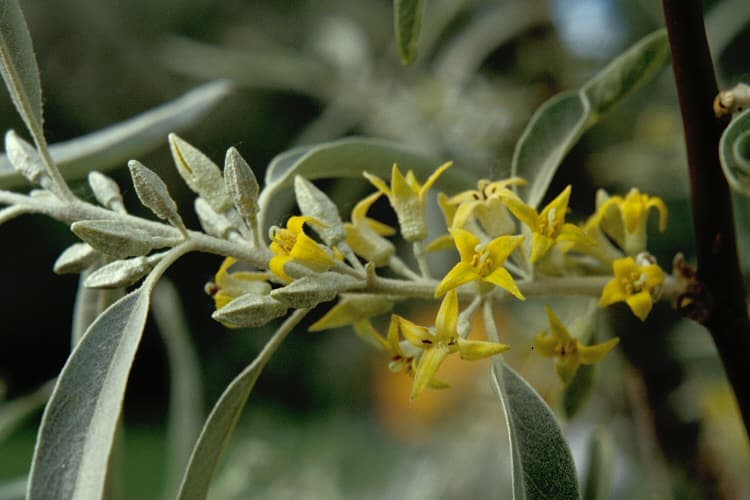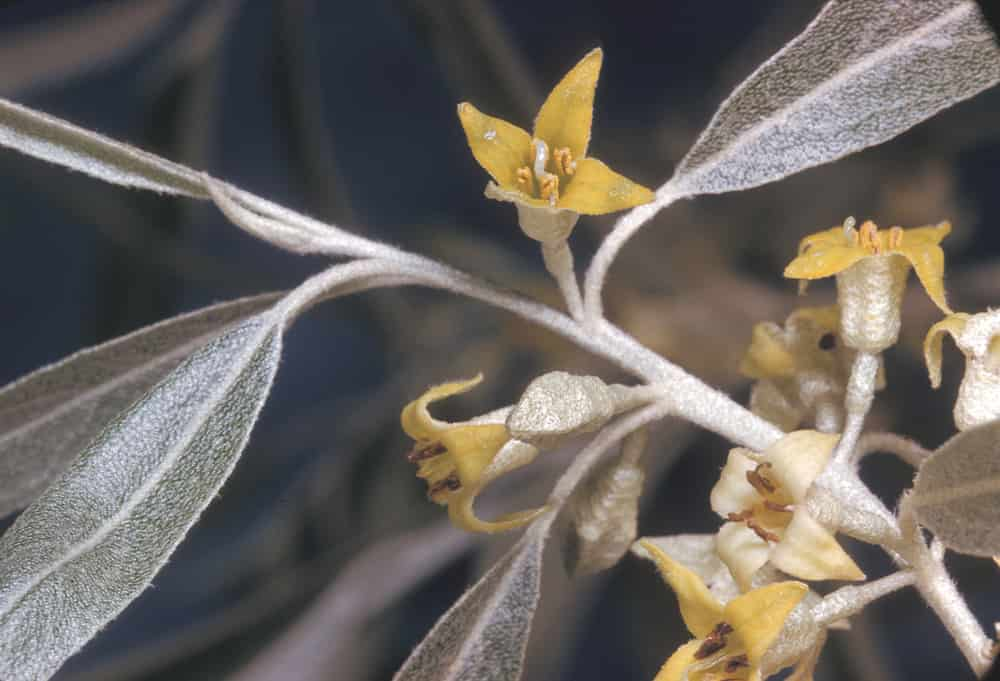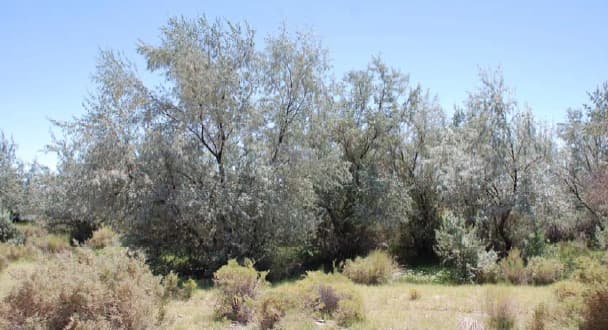Russian Olive Tree (Elaeagnus Angustifolia): Uses, Harms
Russian Olive Tree (Elaeagnus Angustifolia) is a decoration plant that is often grown in the United States, which can also be called silver berry, oleaster, wild olive, American silverberry.
It is an evergreen subtropical tree of the genus Olive (Olea) of the Oleaceae family.
Its homeland is considered to be central and tropical Asia and Greece.
It is a tree species widely grown in countries such as the United States, Abkhazia, the Black Sea coast of Russia, southern Crimea, Georgia, Azerbaijan, Turkmenistan, Iraq, Iran, Pakistan, and northern India.
In 1560, this tree was cultivated in Mexico and Peru, and from there it was brought to America
This plant has been known to humans for more than 4000 years.
The Russian Olive Tree is long-lived, there are even tree species of this tree that are more than 500 years old.
Its body is covered with gray bark. It has a hollow and curved body.
The branches of the Russian Olive Tree are long, gnarled, less drooping.
The leaves of the Russian Olive Tree are almost sessile, simple, lanceolate and entire.
It is a type of plant that does not shed its leaves in winter and is resistant to cold.
The flowering time of the plant depends on the climate.
It usually blooms from the end of April to the beginning of July.
In the climate of the United States, flowering occurs in June-early July.
The flowers of the Russian Olive Tree are very small, 2-4 cm in diameter, fragrant, have a white color with a light cream tint.
The nose of the fruit is pointed, fleshy and has oil in it.
The color of the Russian Olive Tree varies according to the type of plant.
This Plant can produce dense waxy, green, dark purple or black colored fruit.
The fruits ripen 4-5 months after flowering.

What Will We Learn?
Varieties Of The Russian Olive Tree
There are many olive varieties that take their name from the place where they are grown.
Some of these varieties are listed below:
- Kalamata (Greece)
- Chalkidiki (Greece)
- Conservolea (Greece)
- Alfonso (Chile and Peru)
- Bella di Cerignola (Italy)
- Megara-Nafplion, Nyons (France)
- Throumbes Thasos (Thassos and some Aegean Islands)
Russian Olive Tree Care
Growing an olive tree indoors is a laborious task.
Temperature should be the first rule that you will pay attention to in the growth of the plant.
If regular and good observation is not made, the tree may not bear fruit.
For the buds to appear, the Russian Olive Tree must go into hibernation.
Later exposure of olives to low temperatures will cause buds to form.
The optimal temperature for the plant to sleep will be from +1 to +5 degrees.
The flowering of the olive tree begins with the appearance of large white inflorescences.
The plant begins to open its first flowers in April and May.
The ripening of the fruits after flowering occurs in four months.
A good yield of an olive tree is considered to be about 30 kg.
However, if this plant is grown at home, about 600 g yield is considered normal.
The olive tree remains evergreen throughout its life, but can shed its leaves like its larger relatives.
This is considered normal and does not require any precautions.
Growing an olive tree requires patience and attention and is not an easy process.
First you need to obtain olive seeds.
Canned olives will not help you with this.
Olives to be used for planting should be fresh or dried.
Therefore, after picking and cleaning the olives, it is necessary to soak the resulting seeds in a weak alkaline solution for a day, then rinse with water and dry with a paper towel.
Before planting, file the skin of the olive pit to facilitate germination.
It is better to plant it in a flower pot, as it is easier to control seed germination, humidity and temperature.
Cut seeds are placed in a pot with soil 3 cm deep.
Care should be taken not to dry the seed and not to over-wet it.
The first shoots will appear after six months.
Olive trees do not tolerate low temperatures.
Therefore, the reproduction of seeds is carried out in a warm room or in the summer.
To speed up the process of growing an olive tree from a seed, you must germinate the seeds before planting them in the ground.
For this, place the seeds in a shallow container with compost and moisten them daily in a sunny window.
When the seeds germinate, you can start planting in the ground.
Be sure to mix black soil and sand in equal proportions.
Then add peat, dry crushed lime and plant seeds.
Before planting, be sure to test for the presence of drainage (olives do not tolerate stagnant water well).
When the olive seedling gets stronger and grows, it can be planted in the soil with the contents of the pot without damaging the root.
The olive tree is planted in a windless and sunny area in well-heated and moist soil in spring.
Fruiting should be expected three to four years after planting.

How Is The Russian Olive Tree Pruned?
When grown in pots during the growing season, the plant provides rapid growth.
For this reason, anti-aging pruning is recommended.
Long branches are shortened to leave 4-5 pairs of leaves.
How To Reproduce Russian Olive Tree?
To propagate this plant, seed and vegetative propagation are used.
The optimum temperature for seed germination is + 18 + 20 ° C.
When this plant is looked after properly, it will start to sprout in 2-3 months.
Does Russian Olive Tree Harm Other Plants?
No matter how beautiful the appearance of the Russian Olive Tree is, sometimes this tree can harm other plants.
As the tree grows, the vegetation begins to grow and other plants have difficulty germinating and sowing their own seeds.
The Russian Olive Tree significantly reduces the nitrogen content of the soil with its roots.
This results in insufficient nutrition of the plants near the tree.
This tree tends to grow very quickly, causing major problems in the sprouting of other seeds grown near the tree.
The dense leaves of the tree cause the small sprouts to not receive enough sunlight.
This can result in other plants not growing well or wilting completely.
Animals also play a role in the reproduction of this tree.
The birds that eat the delicious olives then take the seeds to another place and throw them there.
These seeds germinate and multiply easily as they are hardy in most weather conditions.
Sometimes this proliferation is not a good situation for farmers.
Because the growth of Russian Olive Trees harms the growth of other plants.
In cases where attention is not paid, the Russian Olive Tree can spread over a large area in a few years and start to cause problems.
Another reason for the spread of the Russian olive is that its external beauty, fragrance is very attractive and its fruit is useful.
If the Russian olive plant spreads, getting rid of it will not be as easy as you think.
In Canada and the United States, the Russian Olive Tree is included in some states on noxid weed lists.
In some cases, the sale and propagation of their seeds may be prohibited.

How Can I Prevent The Russian Olive Tree From Spreading?
If there are olive trees spread over a wide area, it will take a lot of effort to get rid of this situation.
The most common way to destroy this tree without risking other plants is the cut stump method.
You can do log cutting by following the suggestions below:
- Wear protective clothing to prevent thorns from injuring you.
- Cut the stump of the tree from the bottom as far as possible to prevent the Russian olive from growing again.
- Spray a natural herbicide onto the stump along the outer growth rings.
- It should be noted that the Russian olive tree will spread and grow again if herbicides are not applied.
- If the tree you are cutting is large, you can use heavy forestry machinery or a chainsaw.
- After the process is over, take one last look to make sure that no small trees and saplings are left.
- You can also try to pull small saplings and plants by hand to save herbicide.
You can use hard vinegars as herbicide.
Be sure to spray vinegar on the log once every 2 weeks for 2 months.
Be sure to take good care of your garden often to prevent the plant from re-emerging.
Other weeding methods will generally not have an effect on this plant.
Sources:
- WRITTEN FINDINGS OF THE WASHINGTON STATE NOXIOUS WEED CONTROL BOARD DRAFT September 2013
https://www.nwcb.wa.gov/images/weeds/Draft_written_findings_Elaeagnus_angustifolia.pdf - Elaeagnus angustifolia
https://en.wikipedia.org/wiki/Elaeagnus_angustifolia
